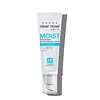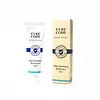What's inside
What's inside
 Key Ingredients
Key Ingredients

 Benefits
Benefits

 Concerns
Concerns

 Ingredients Side-by-side
Ingredients Side-by-side

Water
Skin ConditioningPropanediol
SolventGlycerin
HumectantCaprylic/Capric Triglyceride
MaskingCetearyl Olivate
Niacinamide
SmoothingCaprylyl Glycol
EmollientCeramide NP
Skin ConditioningCeramide AP
Skin ConditioningPhytosphingosine
Skin ConditioningPanthenol
Skin ConditioningCeramide EOP
Skin ConditioningSqualane
EmollientCholesterol
EmollientC13-14 Isoparaffin
EmollientCetyl Palmitate
EmollientPropylene Glycol
HumectantHydrolyzed Sodium Hyaluronate
Skin ConditioningHydrolyzed Hyaluronic Acid
HumectantSodium Hyaluronate
HumectantSodium Acetylated Hyaluronate
HumectantMelaleuca Alternifolia Leaf Extract
PerfumingHamamelis Virginiana Leaf Extract
Skin ConditioningHyaluronic Acid
HumectantPotassium Hydroxide
Buffering1,2-Hexanediol
Skin ConditioningLactic Acid
BufferingVitis Vinifera Seed Oil
EmollientEthylhexylglycerin
Skin ConditioningTocopheryl Acetate
AntioxidantPolyacrylamide
Laureth-7
EmulsifyingCeteareth-12
EmulsifyingSorbitan Olivate
EmulsifyingButylene Glycol
HumectantGlucose
HumectantDisodium EDTA
Cetearyl Alcohol
EmollientHydroxypropyltrimonium Hyaluronate
Potassium Cetyl Phosphate
EmulsifyingSodium Lauroyl Lactylate
EmulsifyingAcrylates/C10-30 Alkyl Acrylate Crosspolymer
Emulsion StabilisingMyristyl Myristate
EmollientXanthan Gum
EmulsifyingGlyceryl Stearate
EmollientCeteareth-20
CleansingCarbomer
Emulsion StabilisingPhenoxyethanol
PreservativeChlorphenesin
AntimicrobialSodium Benzoate
MaskingPotassium Sorbate
PreservativeSodium Hyaluronate Crosspolymer
HumectantPotassium Hyaluronate
Skin ConditioningChondrus Crispus Extract
Skin ConditioningSophora Japonica Flower Extract
Skin ProtectingWater, Propanediol, Glycerin, Caprylic/Capric Triglyceride, Cetearyl Olivate, Niacinamide, Caprylyl Glycol, Ceramide NP, Ceramide AP, Phytosphingosine, Panthenol, Ceramide EOP, Squalane, Cholesterol, C13-14 Isoparaffin, Cetyl Palmitate, Propylene Glycol, Hydrolyzed Sodium Hyaluronate, Hydrolyzed Hyaluronic Acid, Sodium Hyaluronate, Sodium Acetylated Hyaluronate, Melaleuca Alternifolia Leaf Extract, Hamamelis Virginiana Leaf Extract, Hyaluronic Acid, Potassium Hydroxide, 1,2-Hexanediol, Lactic Acid, Vitis Vinifera Seed Oil, Ethylhexylglycerin, Tocopheryl Acetate, Polyacrylamide, Laureth-7, Ceteareth-12, Sorbitan Olivate, Butylene Glycol, Glucose, Disodium EDTA, Cetearyl Alcohol, Hydroxypropyltrimonium Hyaluronate, Potassium Cetyl Phosphate, Sodium Lauroyl Lactylate, Acrylates/C10-30 Alkyl Acrylate Crosspolymer, Myristyl Myristate, Xanthan Gum, Glyceryl Stearate, Ceteareth-20, Carbomer, Phenoxyethanol, Chlorphenesin, Sodium Benzoate, Potassium Sorbate, Sodium Hyaluronate Crosspolymer, Potassium Hyaluronate, Chondrus Crispus Extract, Sophora Japonica Flower Extract
Water
Skin ConditioningNiacinamide
Smoothing1,2-Hexanediol
Skin ConditioningPanthenol
Skin ConditioningEthyl Linoleate
EmollientCaprylic/Capric Triglyceride
MaskingCetearyl Alcohol
EmollientAmmonium Acryloyldimethyltaurate/Vp Copolymer
Centella Asiatica Extract
CleansingAcetyl Glucosamine
Skin ConditioningBifida Ferment Lysate
Skin ConditioningResveratrol
AntioxidantPolyglyceryl-10 Distearate
EmulsifyingGlyceryl Stearate
Emollient4-T-Butylcyclohexanol
MaskingSodium Hyaluronate
HumectantSorbitan Stearate
EmulsifyingPhytosterols
Skin ConditioningN-Palmitoyl Serinol
Skin ProtectingHypericum Perforatum Flower Extract
Skin ConditioningButylene Glycol
HumectantPalmitic Acid
EmollientCeramide NP
Skin ConditioningCarbomer
Emulsion StabilisingPalmitoyl Tetrapeptide-10
Skin ConditioningAcetyl Dipeptide-1 Cetyl Ester
Skin ConditioningSialyllactose
Skin ConditioningCetyl Palmitate
EmollientStearic Acid
CleansingPolysorbate 80
EmulsifyingPentylene Glycol
Skin ConditioningAllantoin
Skin ConditioningSodium Benzoate
MaskingHydrogenated Lecithin
EmulsifyingCitric Acid
BufferingSorbitan Laurate
EmulsifyingMyristic Acid
CleansingTocopherol
AntioxidantHydroxyethylcellulose
Emulsion StabilisingWater, Niacinamide, 1,2-Hexanediol, Panthenol, Ethyl Linoleate, Caprylic/Capric Triglyceride, Cetearyl Alcohol, Ammonium Acryloyldimethyltaurate/Vp Copolymer, Centella Asiatica Extract, Acetyl Glucosamine, Bifida Ferment Lysate, Resveratrol, Polyglyceryl-10 Distearate, Glyceryl Stearate, 4-T-Butylcyclohexanol, Sodium Hyaluronate, Sorbitan Stearate, Phytosterols, N-Palmitoyl Serinol, Hypericum Perforatum Flower Extract, Butylene Glycol, Palmitic Acid, Ceramide NP, Carbomer, Palmitoyl Tetrapeptide-10, Acetyl Dipeptide-1 Cetyl Ester, Sialyllactose, Cetyl Palmitate, Stearic Acid, Polysorbate 80, Pentylene Glycol, Allantoin, Sodium Benzoate, Hydrogenated Lecithin, Citric Acid, Sorbitan Laurate, Myristic Acid, Tocopherol, Hydroxyethylcellulose
 Reviews
Reviews

Ingredients Explained
These ingredients are found in both products.
Ingredients higher up in an ingredient list are typically present in a larger amount.
1,2-Hexanediol is a synthetic liquid and another multi-functional powerhouse.
It is a:
- Humectant, drawing moisture into the skin
- Emollient, helping to soften skin
- Solvent, dispersing and stabilizing formulas
- Preservative booster, enhancing the antimicrobial activity of other preservatives
Butylene Glycol (or BG) is used within cosmetic products for a few different reasons:
Overall, Butylene Glycol is a safe and well-rounded ingredient that works well with other ingredients.
Though this ingredient works well with most skin types, some people with sensitive skin may experience a reaction such as allergic rashes, closed comedones, or itchiness.
Learn more about Butylene GlycolThis ingredient is an emollient, solvent, and texture enhancer. It is considered a skin-softener by helping the skin prevent moisture loss.
It helps thicken a product's formula and makes it easier to spread by dissolving clumping compounds.
Caprylic Triglyceride is made by combining glycerin with coconut oil, forming a clear liquid.
While there is an assumption Caprylic Triglyceride can clog pores due to it being derived from coconut oil, there is no research supporting this.
Learn more about Caprylic/Capric TriglycerideCarbomer is a polymer of acrylic acid. Its main role is to create a gel consistency.
A high amount of carbomer can cause pilling or balling up of products. Don't worry, most products contain 1% or less of carbomer.
Ceramide NP is a type of ceramide and formally known as ceramide 3.
Ceramides are intercellular lipids naturally found in our skin that bonds dead skin cells together to create a barrier. They are known for their ability to hold water and thus are a great ingredient for dry skin.
Ceramides are an important building block for our skin barrier. A stronger barrier helps the skin look more firm and hydrated. By bolstering the skin ceramides act as a barrier against irritating ingredients. This can help with inflammation as well.
If you would like to eat ceramides, sweet potatoes contain a small amount.
Read more about other common types of ceramides here:
Ceramide AP
Ceramide EOP
Cetearyl alcohol is a mixture of two fatty alcohols: cetyl alcohol and stearyl alcohol. It is mainly used as an emulsifier. Emulsifiers help prevent the separation of oils and products. Due to its composition, it can also be used to thicken a product or help create foam.
Cetearyl alcohol is an emollient. Emollients help soothe and hydrate the skin by trapping moisture.
Studies show Cetearyl alcohol is non-toxic and non-irritating. The FDA allows products labeled "alcohol-free" to have fatty alcohols.
This ingredient is usually derived from plant oils such as palm, vegetable, or coconut oils. There is debate on whether this ingredient will cause acne.
Due to the fatty acid base, this ingredient may not be Malassezia folliculitis safe.
Learn more about Cetearyl AlcoholCetyl Palmitate is a wax-like substance.
It comes from palmitic acid and palmityl alcohol. Cetyl Palmitate may not be safe for Malassezia folliculitis, or fungal-acne.
This ingredient is naturally found in the guava fruit and stony corals.
Learn more about Cetyl PalmitateGlyceryl Stearate is a mix of glycerin and stearic acid.
It is used to stabilize the mixing of water and oil ingredients. By preventing these ingredients from separating, it can help elongate shelf life. It can also help thicken the product's texture.
As an emollient, it helps soften skin and supports barrier-replenishing ingredients.
In cosmetics, Glyceryl Stearate is often made from vegetable oils or synthetically produced.
This ingredient may not be fungal-acne safe
Fun fact: The human body also creates Glyceryl Stearate naturally.
Learn more about Glyceryl StearateNiacinamide is a multitasking form of vitamin B3 that strengthens the skin barrier, reduces pores and dark spots, regulates oil, and improves signs of aging.
And the best part? It's gentle and well-tolerated by most skin types, including sensitive and reactive skin.
You might have heard of "niacin flush", or the reddening of skin that causes itchiness. Niacinamide has not been found to cause this.
In very rare cases, some individuals may not be able to tolerate niacinamide at all or experience an allergic reaction to it.
If you are experiencing flaking, irritation, and dryness with this ingredient, be sure to double check all your products as this ingredient can be found in all categories of skincare.
When incorporating niacinamide into your routine, look out for concentration amounts. Typically, 5% niacinamide provides benefits such as fading dark spots. However, if you have sensitive skin, it is better to begin with a smaller concentration.
When you apply niacinamide to your skin, your body converts it into nicotinamide adenine dinucleotide (NAD). NAD is an essential coenzyme that is already found in your cells as "fuel" and powers countless biological processes.
In your skin, NAD helps repair cell damage, produce new healthy cells, support collagen production, strengthen the skin barrier, and fight environmental stressors (like UV and pollution).
Our natural NAD levels start to decline with age, leading to slower skin repair, visible aging, and a weaker skin barrier. By providing your skin niacinamide, you're recharging your skin's NAD levels. This leads to stronger, healthier, and younger looking skin.
Another name for vitamin B3 is nicotinamide. This vitamin is water-soluble and our bodies don't store it. We obtain Vitamin B3 from either food or skincare. Meat, fish, wheat, yeast, and leafy greens contain vitamin B3.
The type of niacinamide used in skincare is synthetically created.
Learn more about NiacinamidePanthenol is a common ingredient that helps hydrate and soothe the skin. It is found naturally in our skin and hair.
There are two forms of panthenol: D and L.
D-panthenol is also known as dexpanthenol. Most cosmetics use dexpanthenol or a mixture of D and L-panthenol.
Panthenol is famous due to its ability to go deeper into the skin's layers. Using this ingredient has numerous pros (and no cons):
Like hyaluronic acid, panthenol is a humectant. Humectants are able to bind and hold large amounts of water to keep skin hydrated.
This ingredient works well for wound healing. It works by increasing tissue in the wound and helps close open wounds.
Once oxidized, panthenol converts to pantothenic acid. Panthothenic acid is found in all living cells.
This ingredient is also referred to as pro-vitamin B5.
Learn more about PanthenolSodium Benzoate is a preservative. It's used in both cosmetic and food products to inhibit the growth of mold and bacteria. It is typically produced synthetically.
Both the US FDA and EU Health Committee have approved the use of sodium benzoate. In the US, levels of 0.1% (of the total product) are allowed.
Sodium benzoate works as a preservative by inhibiting the growth of bacteria inside of cells. It prevents the cell from fermenting a type of sugar using an enzyme called phosphofructokinase.
It is the salt of benzoic acid. Foods containing sodium benzoate include soda, salad dressings, condiments, fruit juices, wines, and snack foods.
Studies for using ascorbic acid and sodium benzoate in cosmetics are lacking, especially in skincare routines with multiple steps.
We always recommend speaking with a professional, such as a dermatologist, if you have any concerns.
Learn more about Sodium BenzoateSodium Hyaluronate is hyaluronic acid's salt form. It is commonly derived from the sodium salt of hyaluronic acid.
Like hyaluronic acid, it is great at holding water and acts as a humectant. This makes it a great skin hydrating ingredient.
Sodium Hyaluronate is naturally occurring in our bodies and is mostly found in eye fluid and joints.
These are some other common types of Hyaluronic Acid:
Learn more about Sodium HyaluronateWater. It's the most common cosmetic ingredient of all. You'll usually see it at the top of ingredient lists, meaning that it makes up the largest part of the product.
So why is it so popular? Water most often acts as a solvent - this means that it helps dissolve other ingredients into the formulation.
You'll also recognize water as that liquid we all need to stay alive. If you see this, drink a glass of water. Stay hydrated!
Learn more about Water